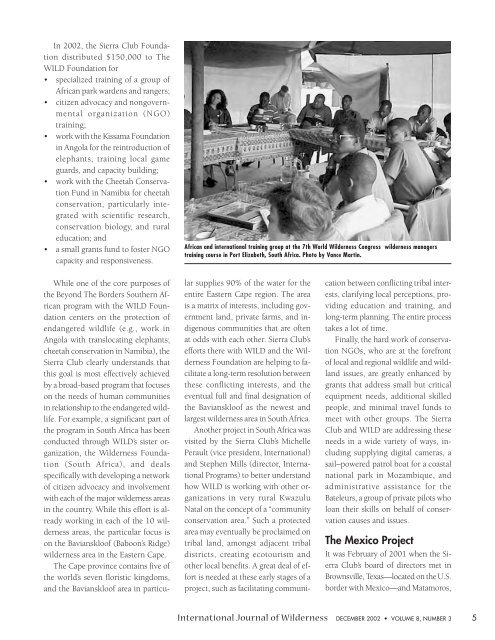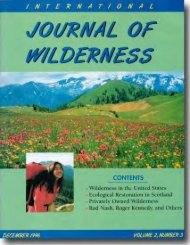Download full PDF - International Journal of Wilderness
Download full PDF - International Journal of Wilderness
Download full PDF - International Journal of Wilderness
Create successful ePaper yourself
Turn your PDF publications into a flip-book with our unique Google optimized e-Paper software.
In 2002, the Sierra Club Foundation<br />
distributed $150,000 to The<br />
WILD Foundation for<br />
• specialized training <strong>of</strong> a group <strong>of</strong><br />
African park wardens and rangers;<br />
• citizen advocacy and nongovernmental<br />
organization (NGO)<br />
training;<br />
• work with the Kissama Foundation<br />
in Angola for the reintroduction <strong>of</strong><br />
elephants, training local game<br />
guards, and capacity building;<br />
• work with the Cheetah Conservation<br />
Fund in Namibia for cheetah<br />
conservation, particularly integrated<br />
with scientific research,<br />
conservation biology, and rural<br />
education; and<br />
• a small grants fund to foster NGO<br />
capacity and responsiveness.<br />
While one <strong>of</strong> the core purposes <strong>of</strong><br />
the Beyond The Borders Southern African<br />
program with the WILD Foundation<br />
centers on the protection <strong>of</strong><br />
endangered wildlife (e.g., work in<br />
Angola with translocating elephants;<br />
cheetah conservation in Namibia), the<br />
Sierra Club clearly understands that<br />
this goal is most effectively achieved<br />
by a broad-based program that focuses<br />
on the needs <strong>of</strong> human communities<br />
in relationship to the endangered wildlife.<br />
For example, a significant part <strong>of</strong><br />
the program in South Africa has been<br />
conducted through WILD’s sister organization,<br />
the <strong>Wilderness</strong> Foundation<br />
(South Africa), and deals<br />
specifically with developing a network<br />
<strong>of</strong> citizen advocacy and involvement<br />
with each <strong>of</strong> the major wilderness areas<br />
in the country. While this effort is already<br />
working in each <strong>of</strong> the 10 wilderness<br />
areas, the particular focus is<br />
on the Baviansklo<strong>of</strong> (Baboon’s Ridge)<br />
wilderness area in the Eastern Cape.<br />
The Cape province contains five <strong>of</strong><br />
the world’s seven floristic kingdoms,<br />
and the Baviansklo<strong>of</strong> area in particu-<br />
African and international training group at the 7th World <strong>Wilderness</strong> Congress wilderness managers<br />
training course in Port Elizabeth, South Africa. Photo by Vance Martin.<br />
lar supplies 90% <strong>of</strong> the water for the<br />
entire Eastern Cape region. The area<br />
is a matrix <strong>of</strong> interests, including government<br />
land, private farms, and indigenous<br />
communities that are <strong>of</strong>ten<br />
at odds with each other. Sierra Club’s<br />
efforts there with WILD and the <strong>Wilderness</strong><br />
Foundation are helping to facilitate<br />
a long-term resolution between<br />
these conflicting interests, and the<br />
eventual <strong>full</strong> and final designation <strong>of</strong><br />
the Baviansklo<strong>of</strong> as the newest and<br />
largest wilderness area in South Africa.<br />
Another project in South Africa was<br />
visited by the Sierra Club’s Michelle<br />
Perault (vice president, <strong>International</strong>)<br />
and Stephen Mills (director, <strong>International</strong><br />
Programs) to better understand<br />
how WILD is working with other organizations<br />
in very rural Kwazulu<br />
Natal on the concept <strong>of</strong> a “community<br />
conservation area.” Such a protected<br />
area may eventually be proclaimed on<br />
tribal land, amongst adjacent tribal<br />
districts, creating ecotourism and<br />
other local benefits. A great deal <strong>of</strong> effort<br />
is needed at these early stages <strong>of</strong> a<br />
project, such as facilitating communi-<br />
cation between conflicting tribal interests,<br />
clarifying local perceptions, providing<br />
education and training, and<br />
long-term planning. The entire process<br />
takes a lot <strong>of</strong> time.<br />
Finally, the hard work <strong>of</strong> conservation<br />
NGOs, who are at the forefront<br />
<strong>of</strong> local and regional wildlife and wildland<br />
issues, are greatly enhanced by<br />
grants that address small but critical<br />
equipment needs, additional skilled<br />
people, and minimal travel funds to<br />
meet with other groups. The Sierra<br />
Club and WILD are addressing these<br />
needs in a wide variety <strong>of</strong> ways, including<br />
supplying digital cameras, a<br />
sail–powered patrol boat for a coastal<br />
national park in Mozambique, and<br />
administrative assistance for the<br />
Bateleurs, a group <strong>of</strong> private pilots who<br />
loan their skills on behalf <strong>of</strong> conservation<br />
causes and issues.<br />
The Mexico Project<br />
It was February <strong>of</strong> 2001 when the Sierra<br />
Club’s board <strong>of</strong> directors met in<br />
Brownsville, Texas—located on the U.S.<br />
border with Mexico—and Matamoros,<br />
<strong>International</strong> <strong>Journal</strong> <strong>of</strong> <strong>Wilderness</strong> DECEMBER 2002 • VOLUME 8, NUMBER 3 5










